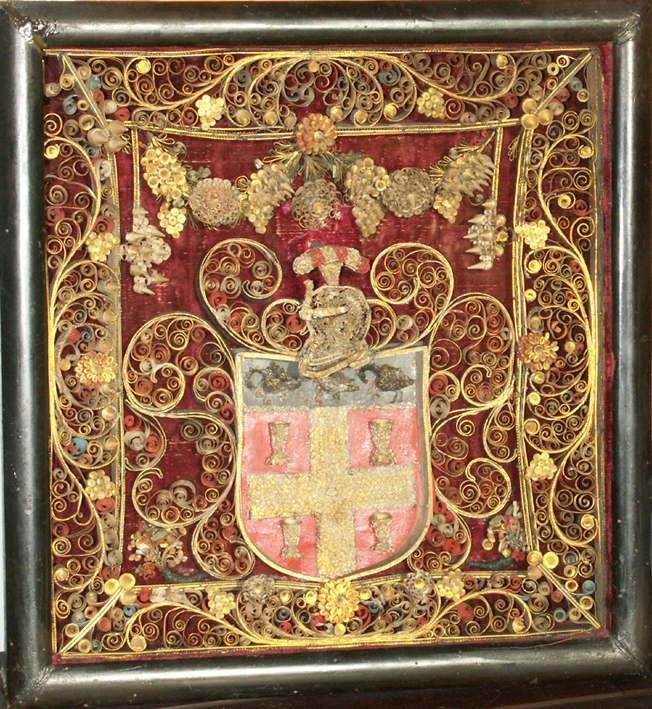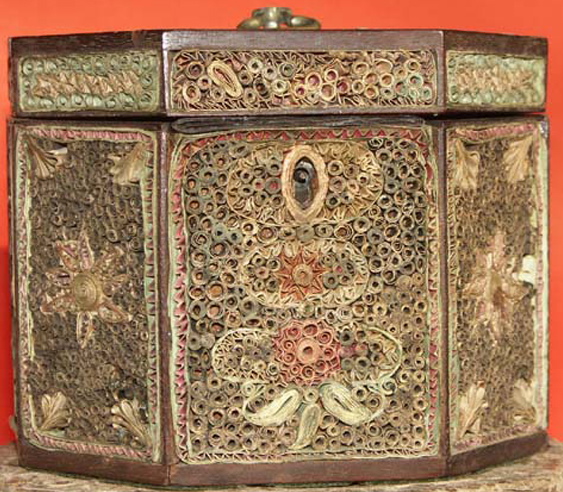Uncategorized
The History Of Quilling
PAPER-ROLLING, PAPER-SCROLLING, FILIGREE, MOSAIC and QUILLING are all names which have been given to our art during its long history. Some sources suggest that many of the techniques we use today were originally practised in Ancient Egypt.
The popularity of Quilling has fluctuated. Work of high quality was achieved by French and Italian nuns in the 16th and 17th centuries; genteel ladies in the Stuart period; ladies of leisure in the Georgian and Regency periods – and it is currently enjoying a modern revival. It also spread to North America with the settlers. Those of us who quill today find we have something in common with Elizabeth, daughter of George III, Joseph Bramah (the famous locksmith), Mrs Delany (pioneer of other paperwork and friend of Jonathan Swift), Jane Austen (who mentions it in her novel ‘Sense and Sensibility’) and the Bronte sisters: quite a distinguished gathering of enthusiasts!

Nuns on the continent decorated reliquaries and holy pictures, adding gilding and much ornamentation. The ecclesiastical connection was maintained when the art spread to England with the development of paper, though vellum and parchment were also used. Poorer churches produced religious pictures with rolled decoration. When gilded or silvered, it was difficult to distinguish it from real gold or silver filigree work.

Quilling was never practised by ‘working-class’ women in the past. Indeed, it was a decorative art which ladies of leisure would use to work panels and coats-of-arms. Later it was extended to include covering tea-caddies, workboxes, screens, cabinets, frames etc. Backgrounds for these often included foil, mica or flaked shells. Beautiful boxes were made by cabinet makers, with recessed sides. These were advertised and sold, often to boarding schools for young ladies. ‘……it affords an amusement to the female mind capable of the most pleasing and extensive variety; and at the same time, it conduces to fill up a leisure hour with an innocent recreation…’ (The New Lady’s Magazine – 1786)
In
1875 an attempt was made to reintroduce the art of Quilling by William
Bemrose, who produced a kit called ‘Mosaicon’, together with a handbook.
Another reference has been discovered in an Edwardian book of household
management entitled ‘Floral Mosaicon’. In the article mention is made
of pieces being purchased by Queen Mary and Queen Alexandra.
Many museums have examples of antique work and our booklet, ‘Finding Antique Quilling’ is currently being updated.
Two
major exhibitions of quilling have been held. One was in 1927 in
London, when mention is made of two Charles I pictures. Another was in
New York in 1988, at the Florian-Papp Gallery, when some superb examples
were on exhibition and sale. Most of these were of European origin. In
1992 and 1997 the Quilling Guild staged International Festivals of
Quilling, the first at Ragley Hall and the second at Chesford Grange in
Warwickshire, when antique pieces and a great many items of modern
quilling were on show. The third International Festival of Quilling was
held in York, North Yorkshire, in 2002, the fourth in Weston-Super-Mare,
Somerset, in 2007, and our very special 30th Anniversary Celebration of
Quillingwas staged in Liverpool in 2013.

